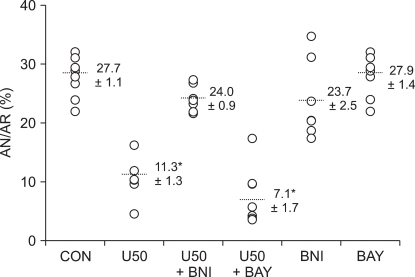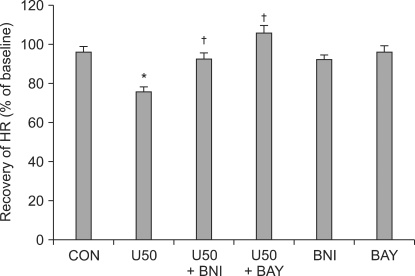1. Lee YC, Jang YH, Kim JM, Kim AR, Kim CJ, Kim YN. Effect of a kappa-opioid receptor agonist U50488H given at early reperfusion phase in isolated rat hearts. Korean J Anesthesiol. 2008; 54:S29–S34.

2. Nayler WJ, Buckley DJ, Leong J. Calcium antagonists and the "stunned" myocardium. Cardioscience. 1990; 1:61–64. PMID:
2102798.
3. Liu X, Engelman RM, Wei Z, Bagchi D, Rousou JA, Nath D, et al. Attenuation of myocardial reperfusion injury by reducing intracellular calcium overloading with dihydropyridines. Biochem Pharmacol. 1993; 45:1333–1341. PMID:
8466553.

4. Nayler WG. Basic mechanisms involved in the protection of the ischemic myocardium. The role of calcium antagonists. Drugs. 1991; 42:21–27. PMID:
1718698.
5. Steenbergen C, Fralix TA, Murphy E. Role of increased cytosolic free calcium concentration in myocardial ischemic injury. Basic Res Cardiol. 1993; 88:456–470. PMID:
8117251.

6. Meissner A, Morgan JP. Contractile dysfunction and abnormal Ca
2+ modulation during postischemic reperfusion in rat heart. Am J Physiol. 1995; 268:H100–H111. PMID:
7840255.
7. Wang QD, Pernow J, Sjöquist PO, Rydèn L. Pharmacological possibilities for protection against myocardial reperfusion injury. Cardiovasc Res. 2002; 55:25–37. PMID:
12062706.

8. Gourine AV, Pernow J, Poputnikov DM, Sjöquist PO. Calcium antagonist clevidipine reduces myocardial reperfusion injury by a mechanism related to bradykinin and nitric oxide. J Cardiovasc Pharmacol. 2002; 40:564–570. PMID:
12352318.

9. Utz J, Eckert R, Trautwein W. Inhibition of L-type calcium currents in guinea pig ventricular myocytes by the kappa-opioid agonist U50488H does not involve binding to opiate receptors. J Pharmacol Exp Ther. 1995; 274:627–633. PMID:
7543570.
10. Jang Y, Xi J, Wang H, Mueller RA, Norfleet EA, Xu Z. Postconditioning prevents reperfusion injury by activating delta-opioid receptors. Anesthesiology. 2008; 108:243–250. PMID:
18212569.
11. Chen Z, Li T, Zhang B. Morphine postconditioning protects against reperfusion injury in the isolated rat hearts. J Surg Res. 2008; 145:287–294. PMID:
18155248.
12. Guppy LJ, Littleton JM. Damaging effects of calcium paradox are reduced in isolated hearts from ethanol-dependent rats: paradoxic effects of dihydropyridine drugs. J Cardiovasc Pharmacol. 1999; 34:765–771. PMID:
10598118.
13. Tai KK, Bian CF, Wong TM. kappa-Opioid receptor stimulation increases intracellular free calcium in isolated rat ventricular myocytes. Life Sci. 1992; 51:909–913. PMID:
1355576.
14. Worthington MG, Opie LH. Effects of calcium channel agonism by Bay-K-8644 on ventricular fibrillation threshold of isolated heart. Cardiovasc Drugs Ther. 1992; 6:597–604. PMID:
1284030.

15. Laurent S, Girerd X, Tsoukaris-Kupfer D, Legrand M, Huchet-Brisac AM, Schmitt H, et al. Opposite central cardiovascular effects of nifedipine and BAY k 8644 in anesthetized rats. Hypertension. 1987; 9:132–138. PMID:
2434422.

16. Murphy JG, Marsh JD, Smith TW. The role of calcium in ischemic myocardial injury. Circulation. 1987; 75:V15–V24. PMID:
3568336.
17. Murphy E, Steenbergen C. Mechanisms underlying acute protection from cardiac ischemia-reperfusion injury. Physiol Rev. 2008; 88:581–609. PMID:
18391174.

18. Shmist YA, Kamburg R, Ophir G, Kozak A, Shneyvays V, Appelbaum YJ, et al. N,N,N',N'-tetrakis(2-pyridylmethyl)-ethylenediamine improves myocardial protection against ischemia by modulation of intracellular Ca
2+ homeostasis. J Pharmacol Exp Ther. 2005; 313:1046–1057. PMID:
15681657.
19. Ferdinandy P, Appelbaum Y, Csonka C, Blasig IE, Tosaki A. Role of nitric oxide and TPEN, a potent metal chelator in ischemic and reperfused rat isolated hearts. Clin Exp Pharmacol Physiol. 1998; 25:496–502. PMID:
9673419.
20. Watts JA, Norris TA, London RE, Steenbergen C, Murphy E. Effects of diltiazem on lactate, ATP, and cytosolic free calcium levels in ischemic hearts. J Cardiovasc Pharmacol. 1990; 15:44–49. PMID:
1688981.

21. Bogaert MG. How do calcium channel blockers prevent cardiovascular events. Are they all alike? Drugs. 1996; 52(Suppl 4):3–7. PMID:
8913713.
22. Coetzee A, Conradie S. Calcium antagonist verapamil and reperfusion injury of the heart. J Cardiothorac Vasc Anesth. 2007; 21:337–343. PMID:
17544883.





 PDF
PDF Citation
Citation Print
Print








 XML Download
XML Download